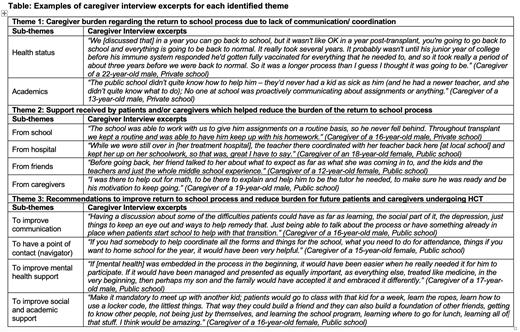Abstract
Introduction: Allogeneic hematopoietic cell transplant (HCT) is an intense process during children's formative years, which can negatively impact their physical, psychological, and socio-environmental domains of quality of life (QOL). Returning to school after HCT is an important indicator of survivors’ health recovery and QOL, as it could provide a sense of normalcy, boost self-esteem, and provide social support to survivors as they cope with treatment-related toxicities. From studies focusing on cancer survivors treated with conventional (non-HCT) therapy, it is known that patients and caregivers often report challenges while returning to school. However, current literature lacks information on these challenges among HCT survivors.
Methods: Between August 2020 and June 2021, we conducted a qualitative interview study of both adolescent HCT recipients treated at Fred Hutchinson Cancer Center (FHCC), Seattle, WA, and their caregivers. This analysis focuses solely on interviews with caregivers of HCT recipients who were 10-18 years of age at HCT and 1-7 years post-HCT. Seventy-three caregivers were approached by mail and asked to respond to a screening questionnaire asking whether their child was enrolled in school before HCT and had returned to school (in-person classroom setting) post-HCT. Additionally, caregivers were asked whether they participated in child's care at least 50% of the time and were English literate. Those who responded affirmatively to all screening questions were considered eligible. A total of 31 caregivers responded to the screening questionnaire (42.4% response rate) and 20 were found eligible. Caregivers were subsequently consented and scheduled for an individual semi-structured interview lasting 30-60 minutes. The interviews were conducted remotely via a secure video platform by one of two interviewers skilled in qualitative interview techniques and having had no clinical contact with the patients and/or caregivers. All respondents were offered a $20 gift card as an incentive for their participation. The interviews were audio recorded, transcribed verbatim, and de-identified by a HIPAA compliant service. Conventional content analysis was used to analyze interview transcripts, and thematic analysis was used to identify and organize emerging themes. Caregivers provided socio-demographic details, and patients’ disease and treatment details were abstracted from medical records.
Results: A total of 19 caregiver interviews were completed (one participant withdrew after initial consent). The majority (95%, n=18) of caregivers were female, 58% (n=11) were Caucasian, and 84% (n=16) were married at time of study. Patients’ average age at HCT and at time of study were 13.5 (range 10-18) years and 17.5 (range 12-22) years, respectively. Forty eight percent of the HCT recipients were female and 76% had received HCT for a malignant disease (acute lymphoblastic leukemia 56%).
Three global themes emerged from caregiver interviews: (1) burden faced by caregivers due to lack of communication/ coordination, (2) support received by patients and/or caregivers which helped reduce the burden of the return to school process, and (3) caregivers’ recommendations to improve the return to school process and reduce burden for future patients and caregivers undergoing HCT. Under the global theme of "burden faced by caregivers", there were two sub-themes: a) health status and b) academics. Under the global theme of "support received by patients and/or caregivers", there were four sub-themes: a) support from school, b) support from hospital, c) support from friends or peers, and d) parental support for the patient. Under the global theme of "recommendations to improve the return to school process", there were four sub-themes: a) to improve communication, b) to have a point of contact (navigator), c) to improve mental health support, and d) to improve social and academic support. Examples of caregiver excerpts for each theme are shown in the Table.
Conclusions: Caregivers of adolescent HCT recipients face several challenges at the time of returning to in-person school post-HCT. Additional work is needed to optimize support for HCT recipients and their caregivers during the return to school process to minimize burden.
Disclosures
Bhatt:Pfizer Inc.: Divested equity in a private or publicly-traded company in the past 24 months; Moderna Inc.: Divested equity in a private or publicly-traded company in the past 24 months; Johnson & Johnson: Divested equity in a private or publicly-traded company in the past 24 months; Rite Aid Corp.: Divested equity in a private or publicly-traded company in the past 24 months. Baker:Bluebird Bio: Consultancy.
Author notes
Asterisk with author names denotes non-ASH members.


This feature is available to Subscribers Only
Sign In or Create an Account Close Modal